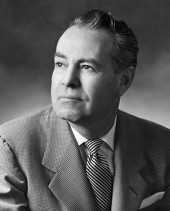 Wallace de Ortega Maxey
Wallace de Ortega Maxey
Profile by David Hughes
Posted January 19, 2014
Wallace de Ortega Maxey was a founding member of the Mattachine Foundation, which was the public face of the clandestine Mattachine Society. In that capacity, Maxey is best known as having hosted the Mattachine’s constitutional conventions, in the spring of 1953, at Los Angeles’ First Universalist Church where he was pastor. Later, Maxey became a champion of free speech, to the point of being a defendant in a significant obscenity case.
Enigmatic Origins
Wallace de Ortega Maxey’s origins and educational record are problematic and are representative of other enigmatic aspects of his ninety years, alluded to below.
School and census records state he was born to Wallace David Maxey, from a pioneer family in Los Angeles, and to Mary (Murphey) Maxey, a native of Illinois, on 22 Feb 1902. His mother died in 1906. Depending on his audience, Maxey claimed either to descend from the Ortegas of the Spanish land grants in California or to belong to a line that included José Ortega y Gasset (but not both at once). The genealogical record may one day connect these strands, but it’s unlikely that the great Spanish philosopher, being about age 20 when Maxey was born, was old enough to be his “maternal great-uncle,” as Maxey wrote years later.
Higher Education and Early Career
Maxey alleged to have attended as many as fifteen institutions of higher learning, but only two of his academic degrees are incontrovertible, and he received both in 1936 in Berkeley, according to school records: a Bachelor of Divinity from Church Divinity School of the Pacific and a Master of Sacred Theology from Pacific School of Religion (PSR).
Prior to this he claimed to have spent time in France, 1924–1926, as “boy-servant” to an “Old Catholic” prelate, Joseph René Vilatte, considered perhaps the most important figure in the Independent Catholic movement in America.[1]The genesis of the story of the (unnamed) “boy-servant” appears to be Peter F. Anson’s profile of Vilatte (Bishops At Large, New York: Ocotober House, 1965). Assisted by researcher … Continue reading Vilatte had ordained Maxey as a priest in 1921, and in 1927, stateside, Maxey was consecrated by William Montgomery Brown of the Old Catholic Church in America.
In 1930, Maxey returned from travel, having investigated Communist activities abroad, intending to embark on a lecture tour sponsored by the superpatriotic Better America Foundation. Ironically, his years of immersion in “Red activities” may have contributed to an unlikely academic thesis, produced in 1936 at PSR, entitled The Struggle Between Classes for the Division of Wealth. In the dissertation, his discussion of capital and the working class is reminiscent of 21st century Occupy Wall Street discourse regarding class interests and class power. For instance, with capital insisting, as it does today, that its interests are everyone’s, Maxey reminded the reader of Britain’s 19th century reformist legislation, the “factory acts.” Even its most fervent proponents cautioned that educating the poor at public expense need not involve the teaching of handwriting; factory workers literate to the point of comprehending their Bible and Church canons would suffice. Maxey concluded his thesis with a critique of revolutionary ideology.
We discover at last that life does not exist for the benefit of the idea, but that the idea, the institution, the rule, exists for the benefit of life, or, as the Gospel has it, “the Sabbath was made for man, not man for the Sabbath.”
As discussed below, Maxey would put this latter notion to the test in a clerical setting very soon after receiving his degree. And the spirit of revolution that marks his thesis would be expressed decades later in a line from his 1963 Mattachine lecture: “The time is present for the revolt of the sexually enslaved.”
After spending the early 1930s working with a theosophical group in California, Maxey entered the above-mentioned Berkeley schools. At the same time he pastored an Episcopal church in San Leandro, being ordained a deacon a month before receiving his degrees. One newspaper wrote at the time, “His church started with nine communicants a year ago and now numbers 80 families.” And a teacher at PSR wrote that Maxey was “a man of superior mental abilities, faithful to all his obligations, gracious in manner, in fact a gentleman and a man of culture.”
But Maxey had displayed enough capriciousness that his bishop in Los Angeles remarked on his “apparent lack of stability.” While not questioning his moral and intellectual aptitude, the bishop suspected, quite presciently, “whether, when ordained, [Maxey] will stick with any degree of permanence.”
Married Strife and Working Life
On July 4, 1936, two months after receiving his degrees, Maxey married. His wife, Elizabeth Atkins Ashburner Ruggles, the widow of an Episcopal minister, came from a prominent Philadelphia family and had founded several business colleges. The wedding, taking place in Washington, D.C., was in a sense an elopement. Bay Area newspapers reported that Maxey had excused his absence from All Saints’ in oddly conflicting ways: the impending death of his grandmother, a trip to Los Angeles to retrieve furniture.
On August 3, Maxey asked to be deposed from the ministry. His request may have stemmed from something as simple—or complex—as a “bitter” and unprecedented split in the Ladies’ Auxiliary Guild involving “exclusion” of some women, as a newspaper put it.
On September 21, Maxey’s wife sued for annulment in Los Angeles on grounds of “fraud and deceit.”
The next day, Maxey said he’d file a counter-complaint contending Elizabeth’s actual age had been undisclosed until after their marriage. There is evidence the two never lived together and that all who knew Maxey had been surprised at the marriage. He said later that he allowed his wife to obtain an annulment so her pension might be restored.
About this time, Maxey apparently fell in with workers’ groups and proposed a non-denominational Christian Workers League. (A year later, he referred to the Catholic Worker movement, which was but three years old.) He claimed that having “pledged myself [to] the poor and down-and-outers” had cost him his church and was “the starting point of marital difficulties.”
In October 1936 Maxey said he was teaching via the New-Deal Works Progress Administration, but he became otherwise employed within nine months, when in the summer of 1937, he traveled to Samoa, Auckland, Fiji, Sydney, Melbourne, Maui, and Honolulu as a waiter or steward on a cruise ship. He wrote that he’d joined a union “in order to get a look at the inside workings. The leaders are practically all members of the Communist Party in name or actually.”
Following this, he pastored a Congregational church in Lawndale, California, resigning in 1939, and again applying for work with the California State Relief Administration in San Francisco. He appears to have spent the next decade as a cleric with yet another Old Catholic fellowship, in Los Angeles, likely with a day job.
Universalism and the Mattachine
On 11 Sep 1949, Maxey was installed as minister of First Universalist Church of Los Angeles. By 1952, he felt comfortable enough to be living in the rectory with his lover, Robert Hernandez Deanda, a Fresno native.
In late 1950, the Mattachine Society was founded by Harry Hay, his lover Rudi Gernreich, Chuck Rowland, Bob Hull, and Hull’s lover Dale Jennings. Sometime prior to 1953, Maxey became a founding member of the group’s Foundation, hosting the organization’s first convention at First Universalist in April and May of that year. (At some point, Bob Hull became the church’s organist.) During the May assembly, the founders resigned in the face of calls for more transparency in the organization, which had operated stealthily from its inception. The founders also had opted to forgo democratic governance until a sense of direction for the Mattachine was obtained. They would recall the convention with some rancor.
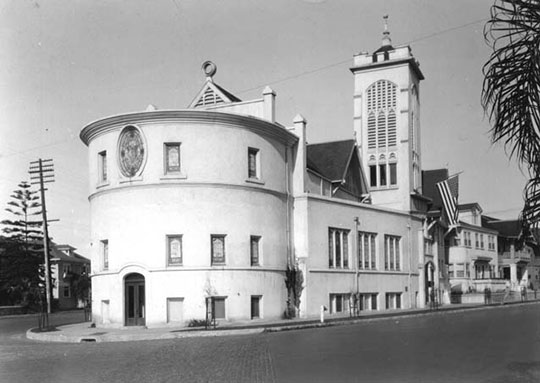
During the gathering, Maxey was nominated to chair the organization, but declined, due to worries regarding his congregation, which were warranted when ONE Confidential magazine published an article a year later that mentioned the convention venue (without naming Maxey).
But as early as November 1953, he had already intended to resign. He did so at the end of March 1954, after preaching on John 7:46—“No one ever spoke like this man,” the reply by officers sent by chief priests and Pharisees to arrest Jesus, upon returning empty-handed.
Maxey admitted that church members had been riled by activities other than the convention. For instance, with Mattachine co-founder Chuck Rowland he had started what essentially was a gay- and bi-friendly singles group at the church: the Crusaders.
In 1953, the Crusaders held a fashion show, which sent some congregants complaining to a California church official. Boldly, the group had advertised its March 1953 meeting in the Mattachine newsletter. Just days before Maxey’s departure, an in-person complaint was filed with the FBI, providing quite some detail on the Maxey–Mattachine connection in just a few lines.
Legacy
If Maxey had a legacy via First Universalist, it was by way of two developments involving gay churches.
A permanent replacement for Maxey finally was secured the summer of 1958, in the person of Carl York Smith (né Schmidt). Smith’s time at the church was short-lived, but not, as with Maxey, due to friction or scandal. It’s likely that First Universalist disbanded altogether in July of 1959, possibly coinciding with an impending Unitarian–Universalist merger.
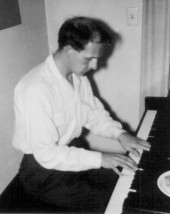
Years later, on a return to Los Angeles, Smith was told of the suicide of the organist who had served at First Church during his pastorship: Mattachine co-founder Bob Hull. Schmidt—then going by his birth name—credited Hull’s suicide as the impetus for beginning a gay ministry.
Schmidt actually secured some backing from the denomination in which he’d since been ordained, the United Church of Christ, and in November 1971, in Denver, he founded The Homosexual Church of the Universe.
By the following April, The Advocate was reporting on Rev. Schmidt’s January 30 arrest regarding a transgenerational relationship, which Schmidt defended in the magazine’s pages after his case was settled in August upon pleading nolo contendere and being given a suspended sentence and $300 fine. In June 2006, Schmidt ended his days as a Buddhist monk, the Venerable Nashville Samitha, a nod to his Bible Belt upbringing.
The second Maxey benefaction is less convoluted. It concerns Chuck Rowland, who had worked with Maxey at First Universalist.
As Rowland told fellow Mattachine founder Harry Hay in 1977, Maxey “had all kinds of ideas about a gay congregation that was to arise within the Unitarian-Universalist organization.” After being marginalized in his post-resignation work with a Mattachine “legal” branch, Rowland was able to channel that effort by working with Maxey on the church’s singles group—the full name was Crusaders for Universal Freedoms.
In October of that year the group met with the ACLU regarding a test case of California’s vagrancy law, which had snared many a gay man, including three Mattachine founders: Dale Jennings, Bob Hull, and Rudi Gernreich. At the same time, Rowland and Maxey worked with a Mattachine offshoot, ONE, Inc., writing for its self-titled magazine. Rowland eventually headed ONE’s Social Services Division and in that capacity, by early 1956, was tasked with developing options to serve gays’ and lesbians’ religious needs.
Using ONE’s promotions committee as a focus group—and absent input from ONE’s executives—Rowland and his collaborators founded the Church of One Brotherhood, option #5 on Rowland’s original list.
In one sense Rowland’s church appears to be the manifestation of Maxey’s “ideas”—the church even had a sort of Crusaders v.2: an “entirely non-liturgical” “youth affiliate” for social activists, dubbed The Prometheans. There’s some slight evidence, however, that Rowland had another motive for the church’s creation: conceiving it as a First Amendment sanctuary in the event of a Cold War crackdown on undesirables.
In his role at ONE, Rowland would have known about what scholar David K. Johnson would call “the lavender scare”: between May 1953 and June 1955, under the cloud of sex perversion, about one federal employee a day was purged. Ten months after the start of the Korean War, J. Edgar Hoover had announced that, in the event of a war with the Soviet Union, he was prepared to round up 14,000 “dangerous” Reds just as Congress considered repurposing abandoned military camps for sequestration, per statute, of political prisoners. The Korean War-era panic had even caused Rowland and Hull to relocate to Mexico in the summer of 1950.
After his resignation in March 1954, Maxey and his lover moved back to Deanda’s home town of Fresno. Maxey remained engaged with the Mattachine (although “withdrawn from activity,” as he stated in print) and founded a Liberal Church, affiliated with Unitarian Universalism.
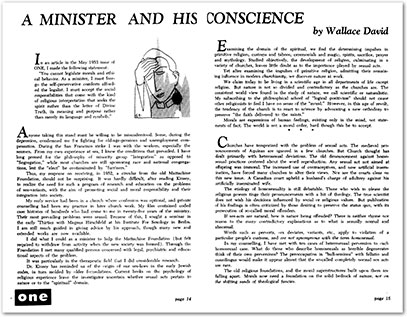 In June, ONE magazine published his “A Minister and His Conscience,” a follow-up to ONE’s May 1953 reprint of remarks he made to the Mattachine executive council.
In June, ONE magazine published his “A Minister and His Conscience,” a follow-up to ONE’s May 1953 reprint of remarks he made to the Mattachine executive council.
In these articles, Maxey mentions the fact that most sex, of whatever variety, is proscribed by law, and yet the only institutions that take pains in enforcement (or, at least, in judgment) are religious. “If sex acts are natural,” Maxey asks, “how is nature being offended?” And if the law is enacted for protection, Maxey declares he’s willing to forgo such security in order to “be about his Master’s business” in ministering to the “sinner,” who is banished from churches filled with the “saved,” whom Jesus “made it clear … had no need of him.” (Writing for ONE, Maxey used the pseudonym Wallace David, never self-identifying as a transgressor.)
By October 1955, after PSR turned down his request to use his 1930s credit towards a 1950s Doctor of Theology degree, Maxey was selling encyclopedias, and by 1957, he was a clerk at a Travelodge Motel, although he professed being an auditor of the chain. In March 1957, he resigned from the Liberal Church; its Universalist contingent had dwindled (supplemented by Unitarians) while he remained unpaid for his services.
A year later, official Universalist correspondence alluded to unnamed matters concerning Maxey. It may have become known that he’d begun work with Fresno publisher Sanford “Les” Aday, who in April 1958 was indicted on obscenity charges in Los Angeles and arrested on a warrant for similar charges from Eugene, Oregon.
Sex & Censorship
Sanford “Les” Aday was the distributor of Maxey’s new venture, the periodical Sex & Censorship, founded by August 1958. The first issue included work by Henry Miller (“The Censor Censured”), Albert Ellis (“Premarital Sex Relations,” i.e., Chapter 3 of the influential psychologist-sexologist’s new Sex Without Guilt), and Lawrence Lipton (“On the Lost Art of Pornography”; in 1959, Lipton’s The New Barbarians looked at the Beat scene from the vantage of his home in “West” Venice, California).
In a “News and Views” clippings roundup, Maxey reprinted a Mattachine Review article by Gregory Trout on Britain’s famous Wolfenden Report, which recommended decriminalization of homosexual behavior. Maxey also invited ONE’s Jim Kepner to contribute an article about the group being given “the green light to a homosexual publication” by the U.S. Supreme Court in January. Also included was a transcript of November 1957 testimony in Los Angeles before the California Assembly Subcommittee on Pornographic Literature. Appearing on behalf of vendors was attorney Stanley Fleishman, who eventually would defend Sanford Aday and Maxey. Sex & Censorship folded, however, after three issues and a name change (to Candida).
Man Is Sexual
In November 1958, Aday published Maxey’s Man Is A Sexual Being: An Existential Approach to the Subject.
As early as March 1959, Maxey was a principal of Aday’s Fabian Books, publisher of Maxey’s book. At some point, Maxey also became a principal of Aday’s West Coast News, his book’s distributor. (It’s said that his main occupation was that of bookkeeper.)
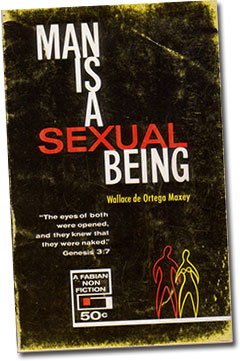 Man Is A Sexual Being takes up where Maxey’s ONE articles leave off: The individual is far ahead of his institutions being free by nature and not by law, creed, or heritage. Once established, religion relies on the past rather than dealing frankly with the issues of the day, yet the number of years that man was free in sexual matters is far greater than the years since religionists attempted to fashion him into a sexless, or solely procreational, being. In adhering to an obsolete creed, man practices Sartre’s “Bad Faith,” denying his Sexual Being — and does so poorly.
Man Is A Sexual Being takes up where Maxey’s ONE articles leave off: The individual is far ahead of his institutions being free by nature and not by law, creed, or heritage. Once established, religion relies on the past rather than dealing frankly with the issues of the day, yet the number of years that man was free in sexual matters is far greater than the years since religionists attempted to fashion him into a sexless, or solely procreational, being. In adhering to an obsolete creed, man practices Sartre’s “Bad Faith,” denying his Sexual Being — and does so poorly.
While Maxey champions nature’s free play, he’s no libertine when it comes to sex for its own sake: Such behavior “is of the lowest animal nature.” His ideas regarding the etiology of deviation are a mélange of nature and nurture. Regarding the former, since we all inherit traits from our differently-gendered parents, a sex-associated hand-me-down may, like hair color, predominate such that a female child might inherit her father’s attraction to women. Yet, regarding the latter, he stresses that deviation can be nipped in the bud by avoidance of divorce and embrace of sex education—the earlier the better—thus facilitating Nihilation of any “lesser,” latent orientation (man being “by nature bisexual”).
Maxey follows this with a twist on eugenics, envisioning a society in which all sex is non-procreative, with “production” regulated and relegated to the artificial insemination of human queen bees, insuring that reproduction will be “so revered there never will occur ‘illigitimates’ [sic] nor ‘misfits’ nor ‘unwanted’ children.” “Every child brought into the world will be a veritable god,” Maxey writes, some pages before again invoking Sartre: that man fundamentally is “the desire to be God” made manifest. In the Free world of Darwin and Einstein (no mention of Marx) that aspiration is closer to being realized.
In May 1963, Maxey delivered a Mattachine lecture entitled “Castrametation: Living Dangerously in Freedom,” which later was published as the first of what was to be a series of “Mattachine Lectures in Contemporary Thought.” If Man Is A Sexual Being was the analysis of a problem, this book is the synthesis of a solution, via existential castrametation, literally the art or act of encamping: “fitting ourselves into a given area, or conditioning a particular area to contain and accommodate the being we truly are, and freely occupy[ing] this selected area.”
Beyond Censorship
Between 1958 and 1967 Aday, Maxey, and their colleagues were prosecuted in a dozen or more jurisdictions from Rhode Island to Hawaii, related to Aday’s publications’ alleged obscenity. By today’s standards, labeling Aday’s books obscene would be absurd. Even contemporary readers took issue, as one wrote to Aday’s Saber Books in June 1959: “Women’s Home Companion Magazine, and others, print more intimate sex articles than I have read in most pocket books.”
According to defense counsel Stanley Fleishman’s analysis of U.S. Supreme Court case law, to be obscene, books under consideration must not have the “slightest redeeming social value” and must demonstrate that “to the average person, applying contemporary community standards, the dominant theme of the material taken as a whole appeals to prurient interest.” But did such standards exist?
According to a West Coast News flier, prosecution witnesses in Youngstown admitted that “they did not read enough to enable them to compare the book with other novels on the market.” Nevertheless, Judge Erskine Maiden Jr. found the book obscene and ordered all copies destroyed.
In May 1960, Aday, Maxey, and West Coast News were indicted on 19 counts by a Grand Rapids, Michigan, grand jury for transporting obscene books into the state. Their conviction in this case would lead to a U.S. Supreme Court decision.
In September 1960, Maxey attended the Mattachine Society convention in San Francisco, but the proceedings troubled him. A Sunday business meeting was held over to Monday, with four hours spent just on delegate credentials and, following committee reports, much discussion regarding the organization’s governing structure.
Maxey was upset, interpreting the trajectory of debate and decisions as “the Mattachine Society being slowly murdered by its so-called loving and sincere members,” which he wrote in the resignation letter that was read after a luncheon. It was happily accepted—but also debated.
Meanwhile, attorney Fleishman had a brilliant strategy in challenging the legitimacy of the Grand Rapids grand jury: that the panel likely didn’t mirror the community whose “standards” they were supposed to be concerned with. But the argument was denied on a technicality.
In November 1960, Aday and Maxey’s co-defendant, Matthew Meehan, died of a heart attack in Fresno at age 49.
The following February, FBI agents began years of visiting newsstands (and Les Aday’s authors), who in some cases were intimidated into canceling orders or returning inventory. Others were resistant: One owner, according to Aday’s salesperson, told agents that “some of the important business men and women, and church people are his regular customers” for Aday’s books.
On May 1, 1962, Mattachine Society co-founder Bob Hull committed suicide. On about the same day, Judge Raymond Starr, presiding in the Grand Rapids case, was hospitalized (after having announced his retirement exactly nine months before). Twenty days later, Les Aday suffered an acute coronary occlusion at his home in Fresno.
On October 29, 1963, the Grand Rapids trial began. Tapped as defense witnesses were blacklisted writer Guy Endore and Los Angeles Times literary editor Robert Kirsch. In November, Fleishman filed a memorandum noting that ten of the twelve jurors sitting in the box had not read a single novel in their lives. Judge Noel P. Fox (replacing Starr) ordered the jurors to read each of the eight books involved in the indictment. Those were the only books allowed in the courtroom; Fox forbade even the mention of comparable titles.
Fleishman threatened to ask prosecution experts about comparisons, however, which appears to have been the prosecutors’ reason for presenting no experts themselves.
Conviction, and Christmas in the Clink
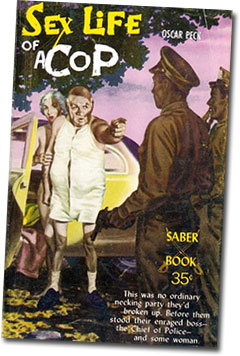 On December 12, after thirteen hours of deliberation, the jury convicted Aday and Maxey on five out of eighteen counts. But only a single book—Sex Life of a Cop—pertained.
On December 12, after thirteen hours of deliberation, the jury convicted Aday and Maxey on five out of eighteen counts. But only a single book—Sex Life of a Cop—pertained.
As Fleishman stated in the unsuccessful petition for bail, “To put it another way, the jury disagreed as to the alleged obscenity of seven out of the eight books set forth in the indictment.”
Judge Fox immediately revoked bail, and thus Aday and Maxey were jailed during the Christmas holiday until their sentencing on December 30. Aday received the maximum sentence of five years and a $5,000 fine on each of five counts; Maxey received fifteen years and $19,000.
Released on bail, they lost their first appeal in March 1966, but the case was sent back to Michigan for consideration of sentence reduction. Two weeks later, Judge Fox reduced the prison terms to ten years for Aday and five for Maxey, with no reduction in fines.
Conviction Capsize
Defense counsel Fleishman petitioned the U.S. Supreme Court for a review of the Grand Rapids case, and on June 12, 1967, the Court struck down Aday and Maxey’s convictions.
The decision was not actually exceptional, since, as reported in The Washington Post the next day, “the Court overturned more than a dozen obscenity convictions in the wake of its May 8 ruling that lower court rulings could not stand under any of several tests of obscenity espoused by individual Justices.” What was exceptional was the example made of Aday and Maxey by the Grand Rapids court in its egregious sentencing.
Endings
Sometime in 1969 or 1970, Maxey retired. In March 1973, Maxey’s lover, Bob Deanda, 52, married Cumorah A. Smith, 47. Bob nevertheless visited Maxey often, and the two would drink together. Deanda and Smith divorced four months later, only to remarry in January of 1976. By the end of that year, Deanda and Maxey appear to have been living together once more.
In 1981, Maxey consecrated Alan Stanford, essentially leaving to him the Catholic Christian church they had founded in 1977. Maxey then seems to have renewed his relationship with the Apostolic Episcopal Church. Maxey’s erstwhile associate, Abbot Donald Weeks, said that in the last years of his life Maxey, due to his drinking, could be plied with liquor in order to supply ecclesial patronage.
Following the death of Mattachine co-founder-turned-couturier Rudi Gernreich in 1985, co-founder Harry Hay wrote Maxey, inviting him to a Los Angeles gathering in Gernreich’s honor—and—“to honor the Dream still lying unresolved in our own hearts.”
By “dream,” Hay wasn’t invoking a generic gay-lib vision. As he wrote, the news of Gernreich’s passing
jarred a number of us down here into a belated realization that—32 years ago—when our magnificent Mattachine Dream faltered and collapsed, when our lovely unanimously-functioning Collective split apart and the Respectables moved to kick us Radicals out, the nine-to-ten of us intimately involved [Maxey included] were so numbed and so heart-broken that I don’t think we ever really said good-bye to the Dream, let alone saying goodbye—and thanks—to one another.
In May 1989, Les Aday died, at age 70. As did Bob Deanda six months later, after complications likely arising after a bout of drinking, at age 69. Maxey’s visitation of Bob’s body and access to his memorial were encumbered by Deanda’s widow.
Sixteen months later, on 12 March 1992, Wallace de Ortega Maxey died in Fresno at age 90, calling Bob Deanda’s name in delirium from his hospital bed. The cause of death stemmed from chronic arteriosclerotic cardiovascular disease, the same condition that had afflicted Les Aday thirty years before.
This profile is adapted from a longer version appearing in the LGBTQ Religious Archives Network, which at the time of my posting was a project of the Center for Lesbian and Gay Studies in Religion and Ministry, Pacific School of Religion, now an independent, charitable organization.
Text by David Hughes. © 2014 David Hughes. All rights reserved.

